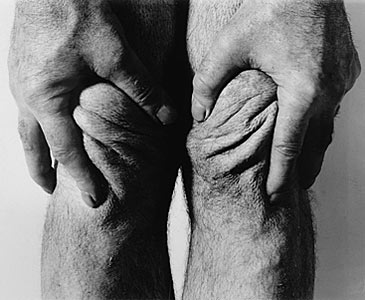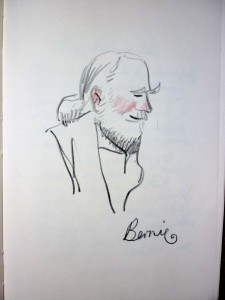(From a talk given at Hart House Theatre by Bernie in Toronto, Sept. 9, 2011 – 340 attending. Sponsored by Centre of Gravity. Notes by MH through veils of dream and distraction)
Bernie Glassman: “The way we can see how deeply one has let go of attachments and realizes the interconnectedness and oneness of life… is how much that person is serving others. If the person is only serving themselves then that’s what they see as the world. If they are interconnected with the whole world, and they see that as one thing, then they can’t help but picking a person up who falls. In the Christian world that’s seeing others as Christ, in the Buddhist world it’s seeing the oneness of life. That’s what I call spirituality.” (From Instructions to the Cook: A Zen Master’s Recipe for Living a Life That Matters, a film by Christof Wolf)

The depth of awakening or enlightenment can be seen in how one serves others. How big is your awakening? Perhaps you are awake to the oneness of Bob. To all the parts of Bob. Seeing how all the parts of Bob are still Bob. Bob is infused with his Bobness. How awakened is Bob? How far does his awakening go? It goes as far as Bob. What about a mother and her child? If the mother is forever tending to, caring about, frustrated but climbing back up onboard the universe of the two of them. How deep is their enlightenment? As deep as mother and child.
What if my left hand is called Mary, and my right hand is called John? They are connected to Bob. Parts of Bob. John suffers a terrible gash, so what does Mary do? Well, Mary (the left hand) might make a mistake, she never studied medicine, so she watches while John (the right hand) bleeds to death. What is the result? John dies, Mary dies, Bob dies. But what if Bob can feel that Mary and John are parts of him? Then if John suffers a gash then Mary will do something, it might be the wrong something, but it will be something. That’s all we can do. To act out of compassion.

Different schools of Buddhism have different ways of deepening our enlightenment. Social engagement is a powerful way of actualizing the oneness of all life. There are three principles that help make social engagement a Buddhist practice.
1. Not Knowing. This doesn’t mean not having enough information. Information is great. Study different languages, read books, talk to the large heads and the small heads. Put it all in your backpack, but don’t get attached to it. Not knowing means entering a situation with openness and listening deeply. You don’t arrive with the idea that you’re going to fix something.
2. Bearing Witness. Aka grokking. Author Robert A. Heinlein coined the term in his best-selling 1961 book Stranger in a Strange Land. In Heinlein’s view, grokking is the intermingling of intelligence that necessarily affects both observer and observed. Heinlein: “Grok means to understand so thoroughly that the observer becomes a part of the observed—to merge, blend, intermarry, lose identity in group experience. It means almost everything that we mean by religion, philosophy, and science—and it means as little to us (because of our Earthling assumptions) as color means to a blind man.”

Bearing witness means spending time in a situation trying to get into the space of non-duality, until you become the situation.
If you can do numbers one and two, then loving action will arise. Attempts to heal will occur.
It’s important to begin in the place of not knowing, where the brain can’t come up with answers. Answers stop us, it’s not the answers that are important, it’s the questions. Questions lead us deeply into a situation. They are the key to not knowing. To being where we are.
We all belong to a club. There are some newspapers, some radio stations, some musics, some people that we believe, that speak our truth and language. And the ones who don’t go to those places are not in our club. What do I do with people who are not in my club? The most usual thing is to ignore them. But there are other, more extreme methods. Gay bashing. Lynching. Auschwitz is an icon, an architecture, that shows us what not belonging to my club means. It was built to kill gays, gypsies, Polish intellectuals and of course Jews.
If we’re all interconnected then we can’t disregard people from all the other clubs. You can’t have one body and having external. There can’t be something outside, something left out.
If we have expectations, my boss, Shakyamuni Buddha says that suffering is sure to follow. He also laid out an eight fold path that can help suffering. Here is the question: how can we enter situations without knowing what is right or wrong? How can we act without having any expectation of result? The work that needs to be done comes out of bearing witness to what is going on – instead of having an idea of how to fix things. This top down model begins with expectations and leads inevitably to suffering.
Fear is one of the major control systems of the individual and the state. The Chinese term for compassion is expressed in their ideogrammatic alphabet using two radicals, two pictures. The first picture offers a view of what we might expect compassion to look like. The second picture means “removal of fear.” In Buddhism the removal of fear is compassion. To be a bodhisattva, to be a vehicle of compassion, means taking on the removal of fear as a practice.

Why am I afraid? Because I’m out of control. How can I let go of my fear? Perhaps I can try to let go of the notion that I’m in control of anything. Instead of controlling I can bear witness to what is happening, without expectation, and wait for loving action to arise, again without expectation.
(portrait by Prashant Miranda)
